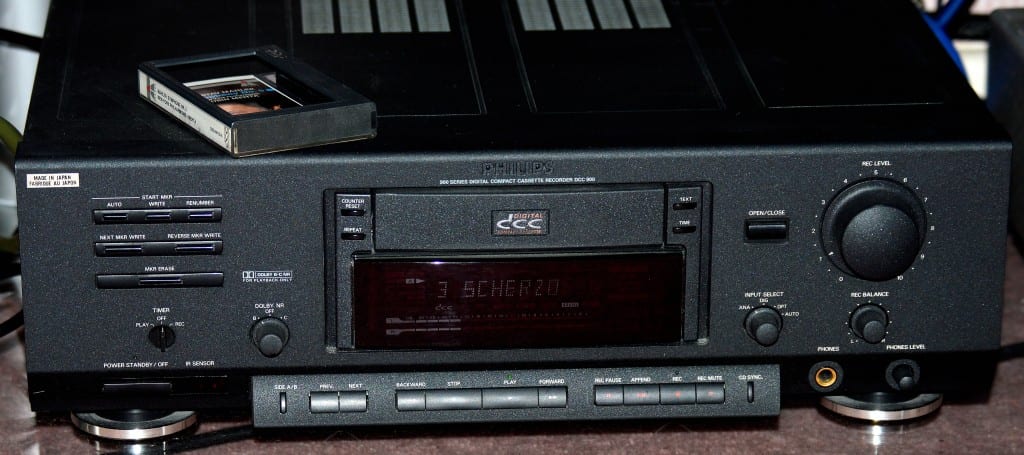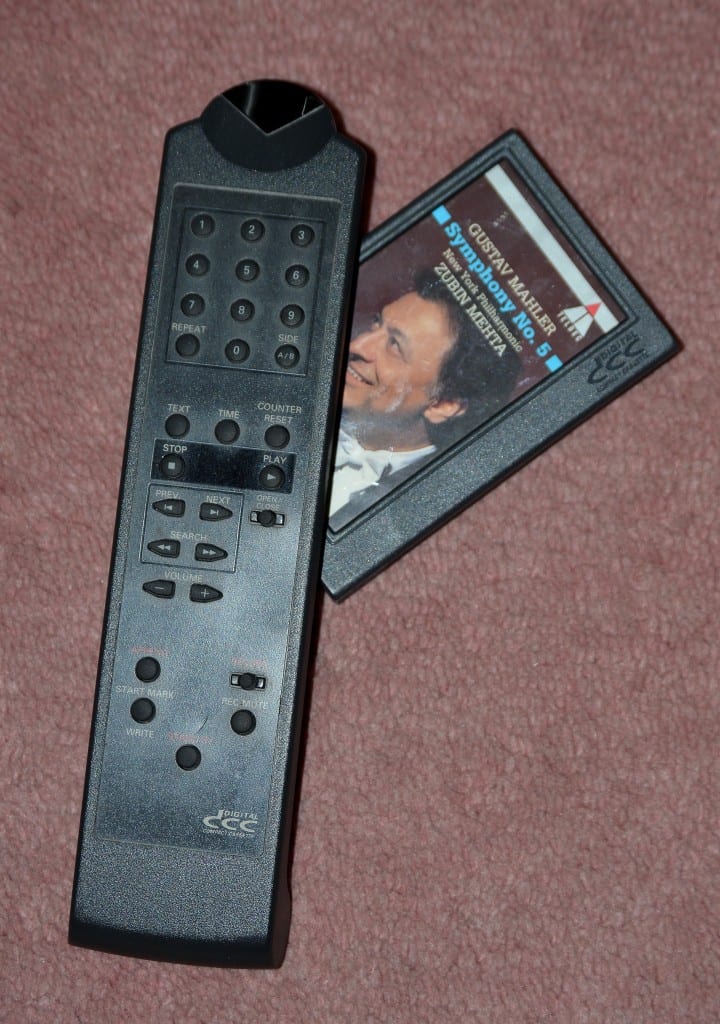Philips DCC900
The Hillman Imp was an amazing invention for 1963. This was the answer to the Mini, doing everything that Alec Issigonis’s baby could do, but adding some extra features that were revolutionary for the time; preceding hatchbacks this car had an opening back window to put in your shopping on the rear seat (or your kids heads) just in case you hadn’t any more room under the front bonnet, and it had more space inside. The light aluminium engine was novel, too, and helped make the car quite nippy (when it worked). What let it down was being a quickly thought out idea and badly made in Scotland. Shame, as I loved it. It could have been an amazing car.
Really Quite Clever
The Philips DCC (Digital Compact Cassette) has many comparisons with the Imp. No, I’m serious. Both continued an old idea, but added new features you could use, if you wanted to. Rather than inventing a Sinclair C5 (Sony’s MiniDisc), which would mean getting rid of your car jack, fluffy seats (and steering wheel), antifreeze and probably your garage, too, you could quite happily continue as you were and take advantage of a few mod cons, like adding luggage. The new DCC allowed you to still play all your wowy and hissy cassettes (with amazingly good clarity) but also to play and record digital recordings using an audio compression codec based upon MPEG-1 Audio Layer I (MP1) and termed PASC (Precision Adaptive Sub-band Coding). PASC lowered the typical bitrate of a CD recording of 1.4 megabits per second to 384 kilobits per second, a compression ratio of around 4:1. This clever machine meant that a new technology was backward-compatible so you didn’t need to eject (permanently) your old recordings of Des O’Conner, and you could now listen with good signal to noise without missing some of the tops, as Dolby B did. What’s more, the PASC system compared favourably with the competing Sony MiniDisc, which used ATRAC compression at around 5:1. If you remember the (still new, but still large) CD was developed by both Sony and Philips, but now they were head to head in creating a smaller system to replace the humble cassette, and one that allowed Walkman sized portable players as well as larger mains units. Sony could make the MiniDisc into an amazingly small box, with a miniature CD rotating at speed inside its individual housing. That was not far removed from the red-book CD. Philip’s idea was something quite different, something quite unimaginable in the beginning of the nineties. How on earth could you get all that digital data onto a 1/8” magnetic tape travelling at 1 7⁄8 inches with a stationary head! All the years of massive VHS and Betamax tapes roaring away with their helical scan heads made this new DCC all the more amazing. The stationary head, though, did have an advantage in that it wasn’t so susceptible to vibration as was my Sony D3 DAT recorder, which wouldn’t play too well in the train on my way to work. And if you remember, portable CD players needed a built in memory to keep them playing when the laser bounced about on the 1806 out of Farringdon. DCC also had less moving parts so cheaper to make, too.
How It Worked
So, how did it all work then? Well, the head assembly contained a combination of two record/playback heads. One was a conventional two-track block contained left and right channels to play your analogue recordings, and the other consisted of no less than 9 mini tracks. When the cassette was set to play the other side then the whole head assembly just switched over. Obviously this wasn’t possible on the few portable units that were made, where indeed the analogue cassette was also played on several tracks on the “digital” head. There was also a conventional erase head. The digital cassette was the same size as the analogue version, though with tape used in video recording. The tape had better protection from sticky fingers and a sturdier box to put it in.
The reason for 9 “tracks” was paramount; eight contained the main PASC and error correction data, plus the system information. The ninth, “Auxiliary Data” track holds mainly track and time information, similar to data on a compact disc, plus extra tape markers for easier operation, for initiating things like start and reverse. This auxiliary data can be scanned during high-speed search, making operation faster and more straightforward, though I didn’t like doing this on my Philips DCC900 in case it wore out the head or the tape! To allow 9 tracks across the 1 7⁄8 inch tape DCC uses magneto-resistive (MR) technology. At the time this was a major advance in thin-film head design. MR’s high-read sensitivity allowed narrower tracks to be used for digital coding, so that overall tape data density is increased. Indeed, each head was 185 µm wide with the track width required for playback at only 70 µm wide. That meant that there was much reduced sensitivity to azimuth error. All information recorded onto tape was grouped into self-contained tape frames separated with little gaps, and each tape frame contained 12,288 bytes of information, of which 8,192 was PASC data. This PASC data was spread across the tape in a checkerboard pattern, with the intention of preventing dropouts caused by damage to the magnetic tape, similar to interleaving on CDs. The CIRC (Cross Interleaved Reed Solomon Code) system found on CD’s and DAT tapes is also employed here, which allows for correction of drop-outs, and this means it can cope with ‘data holes’ of up to 1.45mm in diameter (about 0.03 seconds) and could even compensate for a completely missing data track. The final bit rate to tape is 768 kBps, which is recorded in the eight 96 kBps data tracks.
With PASC coding DCC achieves up to 18-bit resolution (A/D converters on DCC730, 951), 5-22,000Hz frequency response and up to 108dB dynamic range (on the DCC175, 130 portable players) producing ‘superb digital sound of Compact Disc quality’, to quote Philips, and not me obviously. To accomplish this, Philips designed PASC to ignore quieter sounds hidden by those that were louder, and also to ignore the very quietest of sounds, which we wouldn’t be able to hear anyway. The similarities with ATRAC and MP3 are for another day.
There was no problem with azimuth error because the Fixed Azimuth Tape Guidance (FATG) mechanism and the Azimuth Locking Pins (ALPs) fitted to the DCC head assembly ensured not only improved wrap-around tape-to-head contact (much better than on the compact cassette), but also ensured consistent azimuth alignment. You must never demagnetise the digital tape head, and mine has never needed head cleaning (not that it is easy to do that without unscrewing the box). The only temperamental part on the failsafe DCC technology was the micro-switch sensing whether the tape was a DCC or normal cassette.
Entering information (album, track etc) wasn’t as easy on the DCC as on the MD, something we did regularly when recording inserts for sports on news programmes at the BBC in the 90’s. On the DCC you needed to ‘wind’ to the beginning of the tracks to get that dot-matrix display. Tapes theoretically came as large as 120 minutes, though these weren’t easily available, and were the same size and used the same chromium dioxide or ferric tapes. All DCC recorders used the SCMS copy protection system which utilises two bits in the S/PDIF digital audio stream and on the tape to differentiate between “protected” and “unprotected” audio, and between “original” and “copy”.
Doomed To Fail?
DCC was developed in conjunction with Matsushita, and various models were produced by Panasonic (a brand of Matsushita), Grundig and Marantz (related to Philips). Its failure was not only its limitations (track ordering and naming) but the fact that customers wanted instant access to all tracks, something they now had with the CD. Sony could happily rest on its reputation with the Walkman and because their MiniDisc was smaller. My Philips 900, introduced in 1992 at the same time as the MiniDisc began selling machines, has never let me down since the first time it was pulled out of its box. It allows analogue and digital SPDif/Toslink, with quiet running and a cute remote control.
A Multi-Million Pound Flop
Don’t laugh, but I seriously think the failed Philips Digital Compact Cassette was one of the best examples of how the hi-fi industry should have gone forward. Not only was it amazingly clever (I mean, how on earth could you get digital audio from a stationary head with a 1/8” tape passing through at 1 7/8ips!), but more importantly it was backward and forward compatible. As well as being able to play your analogue cassettes its digital output facility permitted copying cassettes them onto an external digital format for future storage. The PASC (Precision Adaptive Sub-band Coding) sound compression far surpassed that of MiniDisc, but like most things, success was led by the consumer. I was brought up to believe that the consumer was always right, but I don’t think that is actually the case. Just 4 years after its inception, Philips gave up with DCC, having been a multi-million pound flop. Remind you of the 8-track tape, or my favourite, the Elcassette (not a holiday resort in Spain), a large cassette by Sony playing at 3 3/4ips? No, Philips should have persevered with their clever baby, in which case waste mountains of discarded audio cassettes wouldn’t have been created quite so soon. Sometimes we are financially led to give up on an idea too soon, like the infamous APT Tilting Train back in the 70’s which was put to bed soon after it failed to bend over a few times. It’s hard to believe, but only nine of the original Espace MPV’s by Renault were sold in the first month it was released. Thank goodness they had the hindsight to continue production otherwise we’d still be driving Hillman Imps.
Janine Elliot


















































































































































































































You must be logged in to leave a reply.